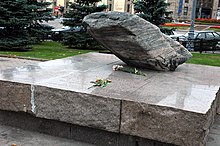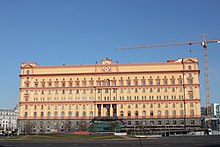Lubyanka
The Lubyanka ( Russian Лубянка ) is the unofficial name of a building on the square of the same name in Moscow . From 1920 to 1991 it was the headquarters , the central prison and the archive of the Soviet secret service in Moscow. Today the Lubyanka is home to the Russian domestic secret service FSB .
In addition, Lubyanka is the name of a subway station on the Moscow Metro on the Sokolnicheskaya Line . The entrances to this underground station are directly opposite the FSB building.
Building history
The building was built in 1897/98 as the administration building of the General Russian Insurance Company by the Russian architect Aleksandr Wassilijewitsch Ivanov. The architect Alexei Viktorovich Shtusev directed a renovation that was delayed by the Second World War from 1940 to 1947. However, this neo-renaissance building only included the left component. According to Shtusev's plans, the right part, dating from the 19th century, was increased in the Andropov era and adapted to the left part. In this way, the facade was in visual harmony by 1983.
Use from 1917
After the October Revolution , the founder of the secret service, Felix Dzerzhinsky, confiscated it for his headquarters. All of his successors and their apparatus also resided there. The secret service chiefs Jeschow and Beria organized the Stalin purges and the exposure of the “ doctors' conspiracy ” against the Russian-Jewish elite from their office on the third floor of the Lubyanka . In 1972 the house became too small for the secret service and the foreign intelligence department moved into a new building in Jassenewo in the south-west of Moscow. The data center of the FSB (Russian Federal Secret Service) was set up in the 1990s in a building directly next to the Lubyanka.
After the collapse of the Soviet Union and the associated dissolution of the KGB , the Lubyanka became the headquarters of the Russian border troops and housed a directorate of the new FSB secret service. The Lubyanka was reorganized in 1998 under the leadership of FSB boss Vladimir Putin . He built a Russian Orthodox chapel for the secret service workers near the building.
Colloquially, the term Lubyanka in Russia is also used as a synonym for repression by any secret government agency, especially when it is intended to express that a person has been secretly arrested and has since disappeared .
jail
The Lubyanka has extensive cell wings for political prisoners. Several hundred thousand people have been interrogated and tortured in the basement since 1920. It was customary not to let her sleep day and night. During interrogation , they were insulted, beaten, and threatened with further torture. Those who refused to say what they asked were handcuffed in the dungeon .
Many prisoners died by suicide , many were shot or hanged in the basements of the Lubyanka after trials without a lawyer . Often was also without process executed : When in December 1941 in the Battle of Moscow , the occupation of the city by the German Wehrmacht threatened some 300 imprisoned, high-ranking Soviet were officers and other prisoners, presumably the KPD co-founder Hugo Eberlein , in Lubyanka shot because of a lack of transportation to evacuate the prison . The basements muffled all noise.
The administrative unit of the NKVD responsible for executions in Moscow Oblast , the so-called Kommandantura, had its seat in the Lubyanka. She was not only responsible for executions in the cellars of the building, but also in the Butyrka prison and on the shooting range in Butowo . The chairman of the Kommendantura was Major General Vasily Michailowitsch Blochin .
The Lubyanka prison remained operational after the collapse of the Soviet Union in 1991.
archive
The archive of the Soviet secret service, which is closed to the public, is stored in the Lubyanka. Files with the names of 50 to 55 million people are kept in large vaults. However, large parts of the holdings are said to no longer exist: When the German Wehrmacht marched on Moscow in October 1941, the documents of the WeTscheKa - GPU - NKVD were said to have been burned in the Lubyanka. The archive of the MGB- MWD is also said to have been destroyed in 1953. The library, which held literature forbidden in the Soviet Union, remained intact. Solzhenitsyn found books by Dos Passos , Esenin and Pasternak there . In 1984 a secret service museum was set up in the building, which documents the "heroic deeds" of the foreign intelligence.

Originally there was a memorial to the founder and leader (1917–1926) of the KGB predecessor Cheka , Felix Edmundowitsch Dzerzhinsky , on an elevation on the square in front of the building . According to many historians, he was the epitome of arbitrary terror by the security organs and the repression of the population. When conservative communist forces failed in their attempt to restore the old Soviet conditions in the August coup of 1991, the statue was removed to the cheers of the population. In October 1990, the human rights organization Memorial erected a memorial to the victims of Stalinism within sight of the Lubyanka .
Political prisoners in the Lubyanka

- Władysław Anders , Polish general (1939)
- Isaak Babel , Russian writer (1939)
- Salomon Bregman , RSFSR Deputy Minister (1952)
- Margarete Buber-Neumann , wife of the KPD Politburo member Heinz Neumann (1938)
- Vladimir Bukovsky , Russian dissident (1963)
- Walter Ciszek , Polish-American Jesuit priest (1941)
- Walter Diettbender , German Comintern secretary
- Alexander Dolgun , American high school student (1948)
- János Esterházy , Hungarian politician (1945)
- Sergei Ivanovich Kawtaradze , Deputy Prosecutor General of the USSR (1936)
- Nikolai Krestinsky , Secretary of the Central Committee and Politburo member of the CPSU
- Aino Kuusinen , Comintern employee and military intelligence agent (1938)
- Vilmos Langfelder , Raoul Wallenberg's chauffeur (1945)
- Walter Linse , German lawyer (1953)
- Georg Lukács , Hungarian literary critic and philosopher (1941)
- Ossip Mandelstam , Russian poet (1934)
- John R. McKone , US soldier (1960)
- Zenzl Mühsam , widow of the poet Erich Mühsam
- Carola Neher , German actress (1936)
- Heinz Neumann , Politburo member of the KPD (1937)
- Freeman B. Olmstead , US soldier (1960)
- Karl Radek , Secretary of the Third International (1937)
- Sidney Reilly , Russian Spy (1925)
- Eddie Rosner , German band leader and jazz trumpeter (1946)
- Alexander Solzhenitsyn , Russian writer (1945)
- Lina Stern , member of the Soviet Academy of Sciences (1952)
- Leopold Trepper , head of the Red Chapel (1945)
- Raoul Wallenberg , Swedish diplomat (1945)
Political executions in the Lubyanka
- David Bergelson , Yiddish writer (1952)
- Jan Bersin , Head of the USSR Military Intelligence Service (1938)
- Nikolai Bukharin , editor-in-chief of Pravda (1938)
- Hugo Eberlein , co-founder of the Spartakusbund and the KPD (between 1941 and 1944)
- Arno Esch , German Liberal (1951)
- Itzik Feffer , Yiddish poet (1952)
- David Hofstein , Russian writer (1952)
- Lev Borisovich Kamenev , member of the Politburo of the CPSU (1936)
- Leib Kwitko , Yiddish writer (1952)
- Salomon Losowski , Deputy Foreign Minister of the Soviet Union (1952)
- Perez Markisch , Yiddish writer (1952)
- Martin Mutschmann , NSDAP Gauleiter of Saxony (1947)
- Kurt Otto Nixdorf , editor of the Moscow Rundschau (1937)
- Alexei Rykov , Soviet Prime Minister (1938)
- Grigory Evsejewitsch Zinoviev , Member of the Politburo of the CPSU (1936)
- Boris Schimelowitsch , Deputy Hospital Director (1952)
- Benjamin Suskin , Director of the Moscow Jewish Theater (1952)
- Andrei Andreevich Vlasov , Soviet Lieutenant General, ROA commander (1946)
Lubyanka Metro Station
Lubyanka Metro Station opened on May 15, 1935 as one of the first stations on the Moscow Metro. It has two entrances, one of which is built into the building of the Detski Mir department store at the northern end of Lubyanka Square and the other leads to a widely branched pedestrian underpass below the same. There is also a transition tunnel from the middle of the platform hall to the Kuznetsky Most station on the Tagansko-Krasnopresnenskaya line .
The station's platform hall, which is separated from the two track areas by simple, rectangular white marble pylons , was only completed in 1975 with the opening of the Kuznetski Most station and the transition to it. Previously there were only two separate platforms at the Lubyanka underground station without an intermediate hall.
From its opening until November 5, 1990, the station was called Dzerzhinskaya in honor of the secret service founder, Dzerzhinsky .
On March 29, 2010, the station, next to Park Kultury underground station on the same line, was one of the two scenes of the March 2010 terrorist attacks .
| Previous station | Moscow Metro | Next station | ||
|---|---|---|---|---|
|
Tschistyje Prudy ← Ulitsa Podbelskowo |
Sokolnicheskaya Line |
Okhotny Ryad Yugo-Sapadnaya → |
||
literature
- The Cheka: Russian calls for help to the world's conscience . Dietz descendants / Vorwärts bookshop, Berlin 1922.
- Aleksander Jakovlev (Ed.): Lubjanka: organy VCK-OGPU-NKVD-NKGB-MGB-MVD-KGB . Moskva 2003.
- VN Chaustov, VP Naumov, NS Plotnikova (eds.): Lubjanka: Stalin i VCK-GPU-OGPU-NKVD, janvar '1922 - dekabr' 1936 . Mezdunarodnyj fond "Demokratija", Moscow 2003.
- VN Chaustov, VP Naumov, NS Plotnikova (eds.): Lubljanka: Stalin i Glavnoe upravlenie gosbezopasnosti NKVD, 1937–1938 . Mezdunarodnyj fond "Demokratie", Moscow 2004.
- Reinhard Müller : Moscow human trap. Exile and Stalinist Persecution. Hamburger Edition, Hamburg 2001, ISBN 3-930908-71-9 .
- Reinhard Müller: "Luck in this time of disaster". Georg Lukács in the Lubyanka . In: Mittelweg 36 , Volume 9, Hamburg Institute for Social Research - Hamburger Edition , Hamburg 2000, Issue 4, pp. 28–48.
Web links
- KGB Museum in Lubyanka (en, ru) ( Memento of February 4, 2001 in the Internet Archive )
Coordinates: 55 ° 45 ′ 39 ″ N , 37 ° 37 ′ 42 ″ E



